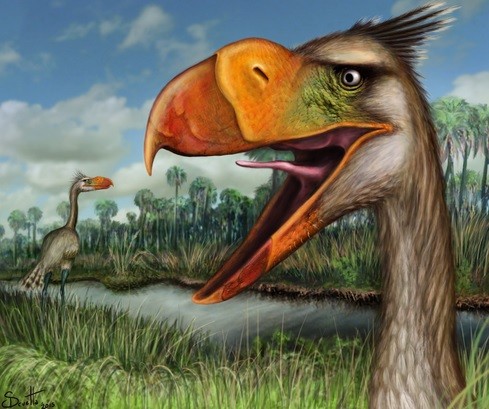New 'Terror Bird' Species Discovered in Argentina Beach
| Ana Verayo | | Apr 11, 2015 05:03 AM EDT |
(Photo : H. Santiago Druetta) Terror birds that once roamed South America killed prey with their large hooked beaks.
A prehistoric "terror bird" skeleton uncovered along a beach in Argentina that suggests these large beaked predators had the uncanny ability to produce deep sounds and also detect them, as well.
About 90 percent intact, this skeleton of "Llallawavis scagliali" is the most complete skeleton to be ever discovered of these voracious creatures. L. scagliali also represents an entirely new species.
Like Us on Facebook
The skeleton's completeness allowed scientists to reconstruct the bird's inner ear. This new insight about the animal's hearing led scientists to conclude the birds probably heard lower pitches and can produce the same low pitched calls to communicate with others.
Paleontologists from Argentina found the remarkable remnants in the cliff region of La Estafeta beach near the tourist city of Mar del Plata.
These terror birds or phorusrhacids were considered to be atop of the food chain in South America after the dinosaurs' extinction some 65 million years ago.
They are flightless monster birds that measure three meters tall; have long legs and dangerous hooked beaks. A prior study revealed the birds kill their prey with a singular fatal blow before it devours the flesh.
The birds evolved throughout history with rather unique sizes and shapes. Most had huge skulls, extremely large beaks with hooks and long hind limbs. These birds lost the ability to fly when they later developed predatory abilities.
The skeleton found on the beach however is a newly discovered species called the Llallawavis scagliali after the study's senior author Fernando Scaglia.
According to the study lead author, Federico Degrange who is a terror bird expert from the National University of Cordoba, the team faced challenges when it came to dealing with the tide upon the discovery of this skeleton. He admits to working fast since the sea can potentially destroy the fossil when the ocean washes it away from the shore.
This study was published in the Journal of Vertebrate Paleontology.
Tags'Terror Bird' New Species Discovered in Argentina Beach, terror bird, Argentina, terror bird new species argentina, south america, prehistoric animals south america
©2015 Chinatopix All rights reserved. Do not reproduce without permission
EDITOR'S PICKS
-

Did the Trump administration just announce plans for a trade war with ‘hostile’ China and Russia?
-

US Senate passes Taiwan travel bill slammed by China
-

As Yan Sihong’s family grieves, here are other Chinese students who went missing abroad. Some have never been found
-

Beijing blasts Western critics who ‘smear China’ with the term sharp power
-

China Envoy Seeks to Defuse Tensions With U.S. as a Trade War Brews
-

Singapore's Deputy PM Provides Bitcoin Vote of Confidence Amid China's Blanket Bans
-

China warns investors over risks in overseas virtual currency trading
-

Chinese government most trustworthy: survey
-

Kashima Antlers On Course For Back-To-Back Titles
MOST POPULAR
LATEST NEWS
Zhou Yongkang: China's Former Security Chief Sentenced to Life in Prison

China's former Chief of the Ministry of Public Security, Zhou Yongkang, has been given a life sentence after he was found guilty of abusing his office, bribery and deliberately ... Full Article
TRENDING STORY

China Pork Prices Expected to Stabilize As The Supplies Recover

Elephone P9000 Smartphone is now on Sale on Amazon India

There's a Big Chance Cliffhangers Won't Still Be Resolved When Grey's Anatomy Season 13 Returns

Supreme Court Ruled on Samsung vs Apple Dispute for Patent Infringement

Microsoft Surface Pro 5 Rumors and Release Date: What is the Latest?










